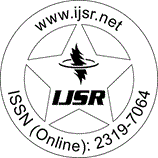Downloads: 142
India | Microbiology | Volume 4 Issue 3, March 2015 | Pages: 138 - 141
Analyzing and Determining the Activity of Antimicrobial, Functional Group and Phytochemicals of Cymbopogon citratus using Well Diffusion, FT-IR and HPLC
Abstract: Cymbopogon citratus belongs to the family Gramineae is herb worldwide known as lemongrass. The prefix lemon owes to its typical lemon like odour, which is mainly due to the presence of citral, a cyclic monoterpene. Cymbopogon citratus fast growing, perennial aromatic grass native to South India and Sri Lanka, now widely cultivated in the tropical areas of America and Asia. Freshly collected and partially dried leaves are used medicinally and are the source of the essential oil. Cymbopogon citratus possesses various pharmacological activities such as anti-amoebic, anti-bacterial, anti-diarrheal, anti-filarial, anti-fungal and anti-inflammatory properties. Various other effects like anti-malarial, anti-mutagenicity, anti-mycobacterial, anti-oxidants, hypo-glycemic and neuro-behavioral have also been studied, plant is used extensively in ayurvedic medicine. Well diffusion method was used for antibacterial and antifungal susceptibility testing. Phytochemical screening was done to know the phytoconstituents present in the plant material. FT-IR and HPLC have been done to know the functional group and to analyze the compounds. Hence this results demands further research to unfold its therapeutic values.
Keywords: Cymbopogon, FT-IR, HPLC, Gramineae, Pseudostem
How to Cite?: R. Uma Maheswari, V. Eugin Amala, "Analyzing and Determining the Activity of Antimicrobial, Functional Group and Phytochemicals of Cymbopogon citratus using Well Diffusion, FT-IR and HPLC", Volume 4 Issue 3, March 2015, International Journal of Science and Research (IJSR), Pages: 138-141, https://www.ijsr.net/getabstract.php?paperid=SUB151785, DOI: https://dx.doi.org/10.21275/SUB151785
